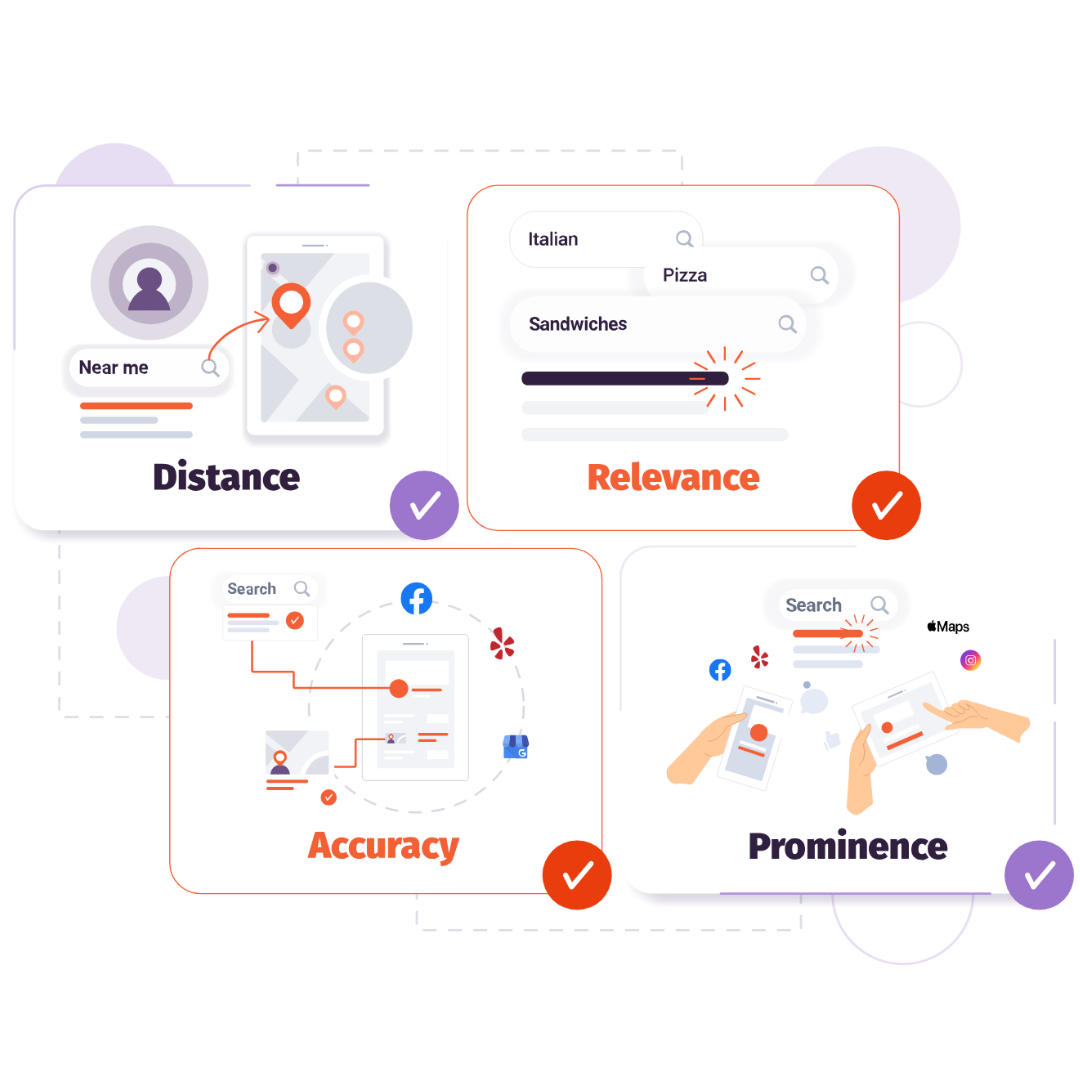Restaurant SEO: Tips to Rank Higher in Local Search and Bring in More Guests
Ready to fill more tables and boost your business? With the right SEO strategies, you can boost your online visibility and drive more traffic to your restaurant's website and ordering platforms. In this article, we’re sharing easy restaurant SEO tips to help you attract more customers and grow your business. From optimizing your website to making the most of reviews, we’ve got all the tips you need. Let’s get started!
What Is SEO?
SEO stands for Search Engine Optimization. And it does just that. SEO helps your business show up on search engines like Google, Bing and more.
In other words, SEO helps your restaurant appear when someone searches for "best restaurants near me" or "Italian restaurant open now."
You may be wondering, how do search engines select what business to highlight for these types of searches? According to Google, there are four main factors taken into account when ranking search results:

- Distance: Proximity considers how far a potential search result is from the location term that was used in the search query. If you don’t specify your location in your search, Google will calculate the distance based on what they do know about your location.
- Relevance: As Google’s strongest signal, relevance refers to how well a local Business Profile matches what a user is trying to find. The more information you add, the better Google can understand your business and pair it with relevant searches.
- Accuracy: Google closely monitors and grades the accuracy of your online data—if there are inconsistencies, it will drop you lower on the list of “near me” restaurant search results.
- Prominence: Prominence is Google’s newest ranking factor and basically looks at how well-known a business is. It is also based on information Google collects from across the web from links, articles, directories, and reviews.
Now that we understand what SEO is and how it works, let’s discuss why it’s important for your restaurant.
The Benefits of SEO for Restaurants
As the restaurant industry becomes more competitive, implementing SEO practices can give your business a competitive edge and help you rank higher in search engine results.
A strong online presence is important for attracting more customers to your restaurant. In fact, 47% of clicks occur on the first 3 results of the Google 3-pack. To be found in the first 3 results of a search result, you need SEO.
When it comes to restaurant SEO, there are a few important things to keep in mind. First, it's crucial to do thorough keyword research to find the most relevant and high-ranking keywords for your business.
This doesn’t have to be complicated either. You don’t need fancy keyword research tools to get started. Simply put yourself in your customers’ shoes and ask yourself, “What are my customers searching to find restaurants like mine?” It could be as simple as what we mentioned above, “Italian restaurant” or “family-friendly restaurant” or any other attributes that make you stand out from other competitors.
Using these keywords in your website's content, meta tags, and headings can improve your search engine rankings and make it easier for potential customers to find you. Plus, keeping an active online presence with regular website updates, accurate listings and review responses can help you gain trust and attract a larger audience.
Tips to Improve Your Restaurant's SEO
Now, let’s dive into how to improve your restaurant SEO to help your local search rankings:
1. Optimize Your Website for Local SEO
A user-friendly, easy-to-navigate site is key for restaurant SEO. Great website content not only pulls in more visitors but also keeps them exploring your menu and offers. Here are some top tips to optimize your restaurant website:
Make it user-friendly and easy to navigate: Keep your site clean and organized with a visually appealing layout. Clear menus and navigation bars help visitors find what they need quickly and easily.
Sprinkle in relevant keywords: Use keywords related to your restaurant and location throughout your site’s content. This boosts your search engine rankings and helps hungry customers find you faster. Make sure to include keywords that are relevant to your restaurant's location throughout your website's content. For example, if you have a restaurant in Miramar, Florida include keywords such as "food near Miramar" or "Best tacos in Miramar” like Talkin’ Tacos has done on their website:
When you search “best tacos in miramar”, you find that Talkin’ Tacos is the first restaurant in the search results. You can see they were intentional in placing keywords strategically on their website listing, meta title and on their website.
Show off with high-quality images and videos: Captivate your audience with stunning photos and videos of your restaurant, dishes, and atmosphere. This makes your site more engaging and invites visitors to learn more.
Go mobile-friendly: 89% of restaurant food searches take place on mobile devices. With more people browsing on their phones, make sure your site looks and works great on phones and tablets. A mobile-responsive design ensures a seamless experience across all devices, helping you attract more visitors no matter where they are searching from.
Consistency is key: Make sure your website has accurate information. This means updated hours, locations, and no outdated menus. Google will crawl your website and if it doesn’t match your listing information, it won’t consider you a trustworthy site and that can affect your local ranking.
2. Create & Maintain Restaurant Listings on Review Sites
Business listings like a Google Business Profile are powerful tools for enhancing your restaurant's online presence and attracting more customers.
Add your restaurant on local directories and review sites such as Yelp, TripAdvisor, and OpenTable. This will increase your visibility and make it easier for potential customers to find you
By creating and optimizing your restaurant listings, you can provide accurate information about your restaurant and improve your visibility in Google search results and other sites. While these tips can be applied to most listings, we are going to talk about how to use Google Business Profiles effectively:
Create and optimize your Google Business Profile: Fill out all the necessary information, including your restaurant's address, contact details, and opening hours. Make sure that this information is accurate and up-to-date
Regularly update your profile with new photos, promotions, and events: Keep your Google Business Profile fresh and engaging by regularly updating it with new photos of your restaurant, special promotions, and upcoming events. This will attract more eyeballs to your restaurant listing.
Update your links: Make sure all of your action buttons like “order now” or “reserve a table” are linked to the correct pages. Bonus points for adding links to your social media channels so customers can find you and engage with your content.
For more tips on this topic, read our blog on Restaurant SEO: A Guide to Google Business Profile Optimization.
3. Respond to Online Reviews
This one may seem a little out of the blue, but reviews are taken into consideration by Google and other search engines for how they rank a business in search results. Businesses that consistently get a large number of high-star ratings and reviews are likely to get more consideration from popular search engines.
Review responses can also influence Google’s ranking for your business. This is because Google takes into account businesses that are engaging with customers through reviews. This is why responding to all reviews is important for restaurants.
Reviews don’t only matter to search engines either. Online review statistics show that 54.7% of customers read at least four reviews prior to purchasing. Reviews influence the customer journey into a restaurant.
Positive reviews can greatly enhance your restaurant's reputation and credibility. But how about negative reviews? While they can be a detractor for customers, how you respond can greatly influence a customer’s decision to give you a chance regardless of the negative review.
Make sure you are monitoring your online review sites and responding to customer reviews, both positive and negative, in a timely and friendly manner. Use your own search keywords in review responses to boost your SEO strategy.
In this review response, you see The Rustic sprinkled in keywords like “good music” and “great food” because those are business attributes they want to be found for. You can do the same with your review responses. Just make sure it sounds natural. Don’t force keywords into every response if it doesn’t make sense.
A great review response can also make the difference in a customer updating their review to a higher star rating. Which again, impacts your SEO. Need help on how to craft the perfect review response? Dive into Anatomy of a Review Response: A Step-by-Step Guide to Managing Guest Reviews & Feedback.
4. Optimize Your Online Menu for SEO
Optimizing your online menu for SEO is a great way to increase your visibility and attract more customers. Here are some tips to get you started with your menu:
Use Descriptive Titles and Descriptions: Make sure each menu item has a clear, descriptive title. Instead of just "Pasta," use "Homemade Spaghetti Carbonara." Use headings to categorize your menu sections, such as Appetizers, Main Courses, Desserts, etc.
Incorporate Keywords: Include relevant keywords in your menu descriptions. Again, think about what customers might search for, like "best vegan burger" or "gluten-free dessert." Be natural about it and only include keywords that make sense.
Showcase your menu with images: Use high-quality images for your menu items and include descriptive alt text for each image on your website. This helps search engines understand what the image is about and improves your SEO. For example, "Image of grilled salmon with a side of rice and vegetables.”
Update Regularly: Keep your menu up-to-date with current offerings. Regular updates signal to search engines that your content is fresh, relevant, and trustworthy.
NO PDF Menus: Have a specific page on your website for your menu rather than embedding it in a PDF or image. This makes it easier for search engines to crawl and index your content.
Stay consistent across sites: Make sure your menu stays consistent and updated on all your sites, not just your website. This includes any listings you may have on Google, Yelp, TripAdvisor, etc. Jack Rabbit is a great example of consistency. You can find the exact same information on their listing as you would on their website, down to the categories and descriptions.
How Marqii can help you with SEO
Search engine optimization for restaurants doesn’t have to be hard. Feeling overwhelmed by the thought of updating your information across multiple sites? Struggling to stay on top of reviews and find ways to include keywords in your responses? That’s where Marqii comes in.
With Marqii, implementing a strong SEO strategy is a breeze. Our dashboard lets you instantly update all your restaurant’s business information, photos and menus across your listings and website with just one click.
Plus, you can view and manage all your reviews in one place, ensuring you never miss a response. We can even handle review responses for you.
Schedule a demo to see how we can help boost your restaurant's SEO and make your life easier!





